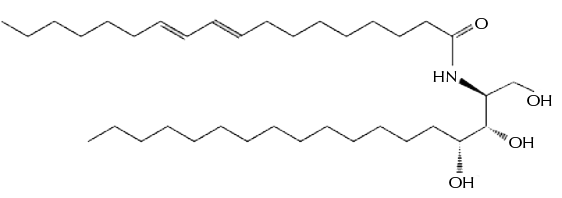What Is Phytosphingosine?
Phytosphingosine is a naturally occurring lipid or fat that is found in your skin’s natural composition. Phytosphingosine is used in cosmetics and skincare products due to its ability to replenish the skin’s natural barrier function. The skin’s natural barrier is an important component of the health of the skin. The skin barrier helps to prevent bacteria, allergens from affecting the skin, and prevents water loss.
Phytosphingosine is a phospholipid, a type of lipid that is a major component of all cell membranes in our bodies. It can be classified as a sphingoid base, a fundamental building block of more complex sphingolipids.
Phytosphingosine is one of the most widely distributed natural sphingoid bases, which is abundant in fungi, plants, and animals. In humans, phytosphingosine is naturally found within the outermost layer of skin, where it occurs in both its free form and as a metabolite of ceramides.

Phytosphingosine
the good:Help to support the health of the skin’s natural barrier, protecting the skin from allergens, bacteria, and water loss.
the not so good:Nothing to look out for here.
Who is it for?All skin types except those that have an identified allergy to it.
Synergetic ingredients:Works well with most ingredients
Keep an eye on:As more research is performed on this ingredient, keep an eye out for other benefits to the skin.
Why Is Phytosphingosine Used?
Phytosphingosine is added to products like moisturizers and anti-aging treatments due to its ability to replenish the skin’s natural barrier function.
Skin’s natural barrier
Phytosphingosine is one type of lipid that makes up the skin’s lipid barrier, which also contains about 50 percent ceramides, 25 percent cholesterol, and about 10 to 15 percent fatty acids. Without these essential lipids, the barrier is weakened. A weak or damaged barrier allows harmful things like allergens, bacteria, and irritants to pass through into the deeper layers of skin, which causes symptoms of dryness, itching, and irritation. Disruption of the skin barrier has been linked with skin conditions such as acne, eczema, sensitive skin, and even signs of aging. Skincare products that contain phytosphingosine can help to prevent these problems.
Water loss
In addition to providing protection from environmental factors, the skin’s lipid barrier also functions to prevent excessive water loss. Transepidermal water loss or TEWL occurs when the skin loses water to the surrounding environment and air. This often occurs as the skin ages and becomes drier or if the skin barrier is disrupted from skin conditions, harsh products, or environmental factors. Phytosphingosine and the other lipids that make up the skin’s barrier help to lock in moisture and prevent skin dehydration.
A 2017 study published in the Archives of Dermatological Research found that phytosphingosine provides a skin moisturizing effect by modulating filaggrin metabolic pathways that are directly responsible for Natural moisturizing factor production. Natural moisturizing factor, a term that describes a group of substances such as amino acids, sugars, electrolytes, etc., that work to keep the skin’s barrier intact, supple, and hydrated. Topical application of phytosphingosine can help to replenish the skin’s NMF.
Anti-aging
Restoring the skin’s NMF is important because it becomes depleted with age and also from routine exposure to sensitizing ingredients like drying cleansing agents and denatured alcohol. This leads to visibly dry, tight-feeling, flaky skin. Thus, by using ingredients that help to replenish NMF, visible signs of aging such as lines, wrinkles, and dry skin, may be reduced. The result is skin that appears more smooth, hydrated, and firm.
Is Phytosphingosine Safe?
While safety data on the use of phytosphingosine in cosmetics is limited, the few studies that have assessed the safety of this ingredient have found little to no side effects. The Material Safety Data Sheet or safety information on using the ingredient for phytosphingosine states that no harmful effects have been reported upon contact with skin, upon ingestion, or upon inhalation. However, phytosphingosine can cause irritation if it comes in contact with the eyes.
A safety evaluation of phytosphingosine published in the Journal of Applied Cosmetology found that this ingredient did not lead to any unwanted skin reactions. In fact, the study results demonstrated that phytosphingosine produced a progressive and significant increase of skin hydration, suppleness, and firmness, as well as fine wrinkle improvement and decrease in transepidermal water loss during the treatment period.
References:
Kim, S et al., 2006. ‘Phytosphingosine stimulates the differentiation of human keratinocytes and inhibits TPA-induced inflammatory epidermal hyperplasia in hairless mouse skin’, Molecular Medicine, vol. 12, pp. 17–24. Kim, B et al., 2014. ‘Phytosphingosine Derivative Ameliorate Skin Inflammation by Inhibiting NF-κB and JAK/STAT Signalling in Keratinocytes and Mice’, Journal of Investigative Dermatology, vol. 134, is. 4, pp. 1023-1032.







